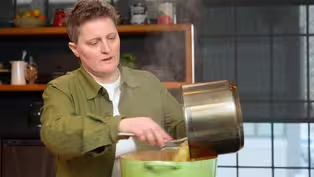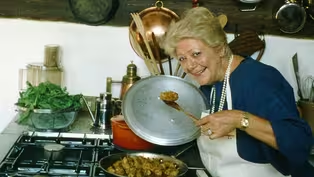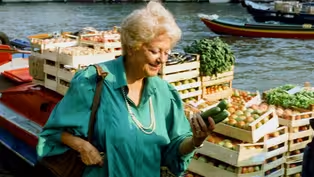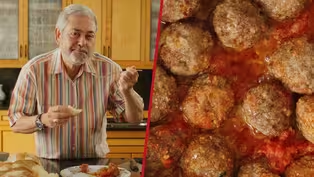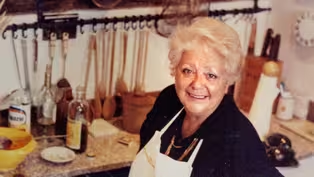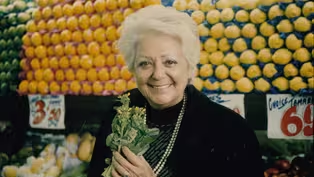
Make the Perfect Roman-style Artichokes
Clip: 7/11/2025 | 8m 4sVideo has Closed Captions
Giuliano Hazan demonstrates his mother's Roman-style artichokes.
One of Marcella Hazan’s most interesting recipes is her upside-down artichokes, also known as Roman-style artichokes. Watch teacher and writer Giuliano Hazan make it here and level up your artichoke game.
Problems playing video? | Closed Captioning Feedback
Problems playing video? | Closed Captioning Feedback
Support for American Masters is provided by the Corporation for Public Broadcasting, AARP, Rosalind P. Walter Foundation, Judith and Burton Resnick, Blanche and Hayward Cirker Charitable Lead Annuity Trust, Koo...

Make the Perfect Roman-style Artichokes
Clip: 7/11/2025 | 8m 4sVideo has Closed Captions
One of Marcella Hazan’s most interesting recipes is her upside-down artichokes, also known as Roman-style artichokes. Watch teacher and writer Giuliano Hazan make it here and level up your artichoke game.
Problems playing video? | Closed Captioning Feedback
How to Watch American Masters
American Masters is available to stream on pbs.org and the free PBS App, available on iPhone, Apple TV, Android TV, Android smartphones, Amazon Fire TV, Amazon Fire Tablet, Roku, Samsung Smart TV, and Vizio.
Buy Now

A front row seat to the creative process
How do today’s masters create their art? Each episode an artist reveals how they brought their creative work to life. Hear from artists across disciplines, like actor Joseph Gordon-Levitt, singer-songwriter Jewel, author Min Jin Lee, and more on our podcast "American Masters: Creative Spark."Providing Support for PBS.org
Learn Moreabout PBS online sponsorship(pleasant music) (food sizzling) - Hello, I'm Giuliano Hazan.
Today I am going to make braised artichokes Roman style.
This is one of my mother Marcella Hazan's recipes from her cookbook "Essentials of Classic Italian cooking."
These artichokes are a wonderful appetizer and in fact, my mother served these to the New York Times food editor, Craig Clayborne, when he came over for lunch.
So the first thing that we're going to do is we're going to trim the artichokes.
If you've ever eaten an artichoke leaf by leaf, you know you scrape the bottom part with your teeth.
Well, that's the tender part and that's the part that we wanna keep.
And we want to get rid of all the other parts.
So what we do is we take our artichoke and we start removing the leaves.
We wanna snap them where they snap naturally and then pull the leaf off.
You can see that this bottom part is still there.
That's the part that you would've scraped off with your teeth, if you ate it leaf by leaf.
(pleasant music) (leaves ripping) One thing I like to do is to take a lemon, cut it in half.
(board clacks) And you know how artichokes can make your fingers dark.
If you rub lemon all over your hands like this, it will prevent that from happening.
And when the artichokes are trimmed, we're going to put them in some water that has some lemon juice in it.
(pleasant music) Then you cut the top of the artichoke off.
(artichokes scrunching) The stem of the artichoke is very good.
So we're not gonna cut off the stem.
We're actually gonna be brazing these upside down with the stem sticking up.
But you do wanna cut off the little bit, that's the bottom of the stem because that part usually brown and dried up.
And then the stem has a white part in the center.
That's the part that's tender and good.
So what we wanna do is we want to save that part and trim away all of the rest.
(pleasant music) Now the stem that we have left there is all tender.
This outer part that's dark green is also tough.
So we do need to trim that part.
The knife that I'm using is curved.
This is what they call a bird's beak.
And it works perfectly for the artichokes because it helps that the blade is slightly curved.
As you go around the artichoke like this and you trim away the dark green outer part.
If you're good at carving or whittling, you'll be very good at this.
And then I take my lemon, and I rub it on the outside of the artichoke.
(pleasant music) There's one more thing that we have to remove, and that's the choke, this inside part where all those purple leaves are.
And to do that, I use a dinner knife.
It has to be something with a rounded tip.
What we wanna do is we want to pry that choke there using this knife.
So I go all the way around on the outside of the purple leaves till I reach the heart, and then I want to scrape all that stuff out.
And then finally, another little bit of lemon directly inside like that rub.
And then you put it in your lemon water.
(pleasant music) So now that the artichokes are trimmed, we're going to make the herb mixture that we're going to season them with.
I have parsley, mint, and garlic.
So first I'm gonna start with the parsley.
(pleasant music) There's actually a saying in Italy that somebody who turns up everywhere is kind of like parsley because we always use parsley.
(pleasant music) (parsley scrunching) (board scraping) So now we're going to chop some mint and add some mint to our mixture.
(board knocking) So now we're going to add it to our parsley.
(board scraping) The last thing we need to chop is the garlic.
I don't like whacking the blade of a sharp knife, so I use the handle instead.
When the garlic cracks, then you'll be able to remove the skin easily.
(garlic snipping) (board scraping) And add it to our mixture.
Remember, you have to salt all four artichokes and some pepper.
Mix it all up nicely.
(pleasant music) And then I put a little more of the mixture inside the artichoke and then some on the outside.
(pleasant music) And depending on how fresh and tender the artichokes are, they could take anywhere from 20 to 35 minutes to cook.
Good extra virgin olive oil.
And then they need some water to cook and be halfway up the artichokes.
So they need to cook with the lid very tightly sealed on top.
And the trick to having a very tight seal is to use a wet towel.
I wrap the wet towel around the lid, bringing the ends up over the top and then put the lid on.
And that way it'll be really nice and tight, so you can start to hear the difference when all the water has evaporated.
Because the artichokes start to saute almost fry in the olive oil.
(pleasant music) (artichokes sizzling) So we want to take them out right away and put them on a serving platter to cool 'cause if you leave them in the pot, then they're gonna soak up all the oil, and we wanna save the oil and pour it on top of them afterwards when we serve them.
We are ready to serve our artichokes.
Put one on your plate.
We use a smaller plate because it's an appetizer.
And then this is the olive oil that was left in the pan.
And so we just pour a little bit of this over the artichoke.
(pleasant music) Let's see if it was worth the effort.
Mmm, it's so tender, dip it in the olive oil.
(pleasant music) Definitely worth it.
Well, I hope you enjoy this recipe, and I hope that you won't feel too intimidated by doing artichokes because they're really worth it.
Buon appetito!
(liquid gurgling)
Chef April Bloomfield makes Marcella Hazan’s tomato sauce with onion and butter
Video has Closed Captions
Clip: 7/11/2025 | 3m 29s | Watch chef April Bloomfield make Marcella Hazan’s tomato sauce with onion and butter. (3m 29s)
How Marcella Hazan accidentally became a teacher
Video has Closed Captions
Clip: 7/11/2025 | 2m 17s | Discover how Marcella Hazan became a teacher. (2m 17s)
How Marcella Hazan published her first cookbook
Video has Closed Captions
Clip: 7/11/2025 | 2m 39s | Marcella Hazan wrote “The Classic Italian Cook Book” with her husband Victor translating. (2m 39s)
Make Marcella Hazan’s easy roast chicken with lemon
Video has Closed Captions
Clip: 7/11/2025 | 2m 29s | Watch chef Shola Olunloyo make Marcella Hazan’s simple roast chicken with lemons. (2m 29s)
Make the Perfect Meatballs and Tomatoes
Video has Closed Captions
Clip: 7/11/2025 | 5m 31s | Giuliano Hazan demonstrates his mother's meatballs and tomatoes. (5m 31s)
Video has Closed Captions
Preview: 7/11/2025 | 2m 11s | Discover how celebrated cookbook writer Marcella Hazan shaped Italian cuisine in America. (2m 11s)
These Italian ingredients didn’t exist in America before Marcella Hazan
Video has Closed Captions
Clip: 7/11/2025 | 1m 41s | Marcella Hazan introduced classic Italian ingredients to America, including extra virgin olive oil. (1m 41s)
Providing Support for PBS.org
Learn Moreabout PBS online sponsorshipSupport for PBS provided by:
Support for American Masters is provided by the Corporation for Public Broadcasting, AARP, Rosalind P. Walter Foundation, Judith and Burton Resnick, Blanche and Hayward Cirker Charitable Lead Annuity Trust, Koo...

